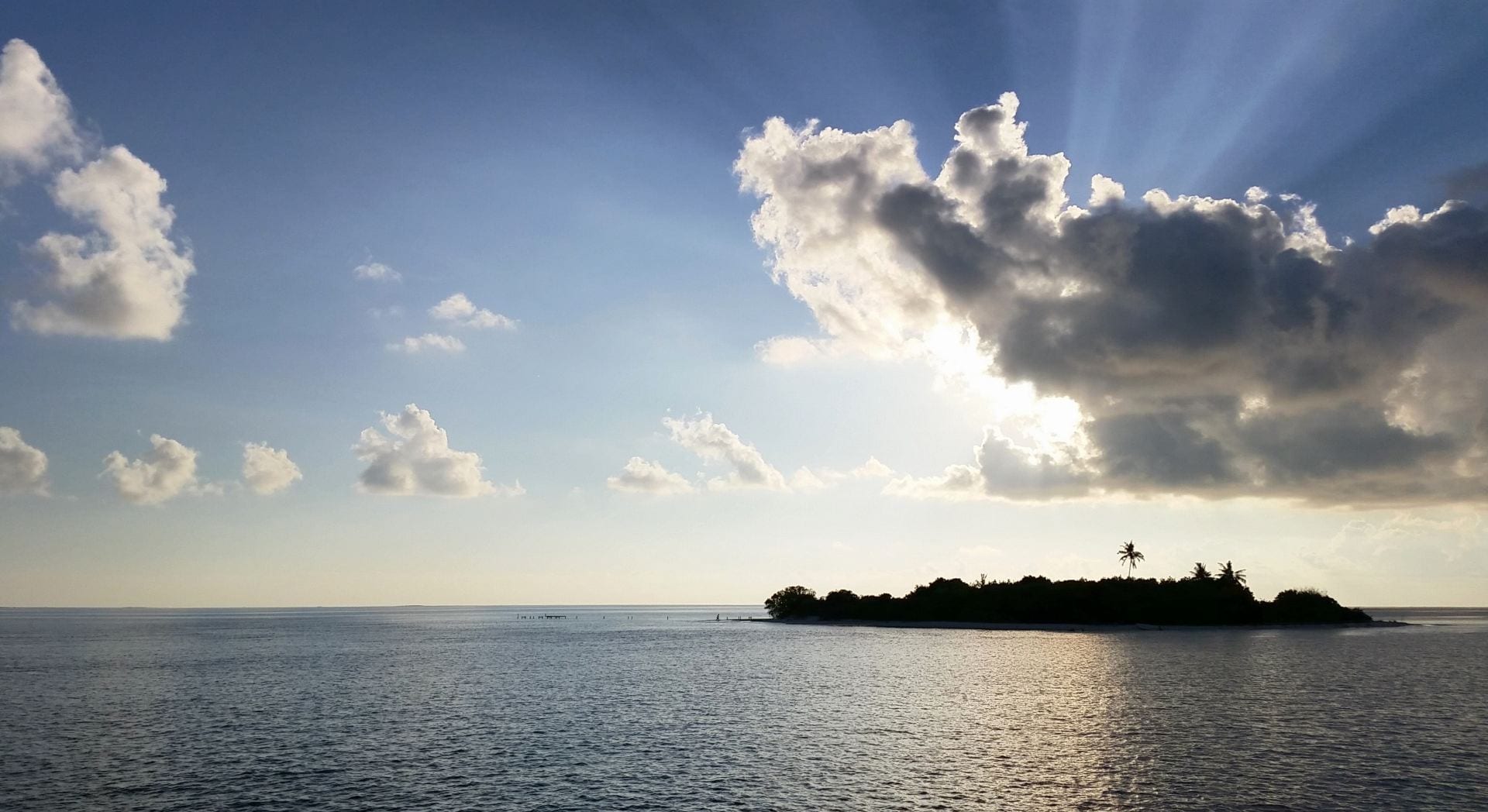
Modelling the diurnal cycle* of winds and clouds
Dr Gilles Dominique Bellon, Senior Lecturer, Physics

Cloud forming above a tropical island
A day on a tropical island
Over a tropical island, the temperature rises after sunrise and become warmer than the temperature over the ocean around. This causes a sea breeze that brings humidity over the coast, where clouds develop and precipitation starts around midday. Afterwards, the precipitating clouds propagate inland until the early night. Then the island cools, a land breeze develops, and clouds form off the coast and propagate towards the open ocean. Of course, the canonical diurnal cycle of winds and clouds is modulated by many factors: the location of the island and the season, the geography of the island (shape, size, topography), and the state of the atmosphere at the regional, “synoptic” scale (dominant winds, humidity) all have an influence on this diurnal cycle. In return, archipelagos can have a strong impact on the regional climate through the interaction of scales between the local diurnal processes and the regional mechanisms, which set the long-term climate.
Our project investigates mechanisms of the meteorological diurnal cycle over islands and the factors that affect them as well as how groups of islands can impact the regional climate. To do so, we analyse high-resolution satellite estimates, and we perform simulations of the climate over fictional, idealized islands using a cloud-resolving model, a high-resolution model of the atmosphere based on the anelastic equations (i.e., simplified version of the Navier-Stokes equations, in which air density is considered to almost follow a reference vertical profile) which explicitly models the large-cloud processes.
Both the analysis of observations and the modelling work require large computer resources. The largest computations are performed on the NeSI High Performance Computing facility, and some post-treatment and smaller analysis run on a Research Virtual Machine that the Centre for eResearch (CeR) set up for our group. CeR also provided much needed storage space. The storage on Seafiles allowed us to share our data with oversea partners. For outreach purpose, CeR Visualisation Specialist Nick Young also helped to create a video on YouTube (see below) of a simulation of the diurnal formation of clouds over a circular island.
A two-day cloud-resolving simulation of the atmosphere around a circular tropical island of 70 km in diameter. Colors at the surface show the temperature of surface air while grey and black show surface precipitation rate. White show clouds and blue and purple show rain falling from these clouds.
*Note: Definition of Diurnal cycle from Wikipedia: A diurnal cycle is any pattern that recurs every 24 hours as a result of one full rotation of the Earth round its own axis. In climatology, the diurnal cycle is one of the most basic forms of climate patterns. The most familiar such pattern is the diurnal temperature variation. Such a cycle may be approximately sinusoidal, or include components of a truncated sinusoid (due to the sun’s rising and setting) and thermal relaxation (Newton cooling) at night.
See more case study projects

Our Voices: using innovative techniques to collect, analyse and amplify the lived experiences of young people in Aotearoa

Painting the brain: multiplexed tissue labelling of human brain tissue to facilitate discoveries in neuroanatomy

Detecting anomalous matches in professional sports: a novel approach using advanced anomaly detection techniques

Benefits of linking routine medical records to the GUiNZ longitudinal birth cohort: Childhood injury predictors

Using a virtual machine-based machine learning algorithm to obtain comprehensive behavioural information in an in vivo Alzheimer’s disease model

Mapping livability: the “15-minute city” concept for car-dependent districts in Auckland, New Zealand

Travelling Heads – Measuring Reproducibility and Repeatability of Magnetic Resonance Imaging in Dementia

Novel Subject-Specific Method of Visualising Group Differences from Multiple DTI Metrics without Averaging

Re-assess urban spaces under COVID-19 impact: sensing Auckland social ‘hotspots’ with mobile location data

Aotearoa New Zealand’s changing coastline – Resilience to Nature’s Challenges (National Science Challenge)

Proteins under a computational microscope: designing in-silico strategies to understand and develop molecular functionalities in Life Sciences and Engineering

Coastal image classification and nalysis based on convolutional neural betworks and pattern recognition

Determinants of translation efficiency in the evolutionarily-divergent protist Trichomonas vaginalis

Measuring impact of entrepreneurship activities on students’ mindset, capabilities and entrepreneurial intentions

Using Zebra Finch data and deep learning classification to identify individual bird calls from audio recordings

Automated measurement of intracranial cerebrospinal fluid volume and outcome after endovascular thrombectomy for ischemic stroke

Using simple models to explore complex dynamics: A case study of macomona liliana (wedge-shell) and nutrient variations

Fully coupled thermo-hydro-mechanical modelling of permeability enhancement by the finite element method

Modelling dual reflux pressure swing adsorption (DR-PSA) units for gas separation in natural gas processing

Molecular phylogenetics uses genetic data to reconstruct the evolutionary history of individuals, populations or species

Wandering around the molecular landscape: embracing virtual reality as a research showcasing outreach and teaching tool
























































































































































